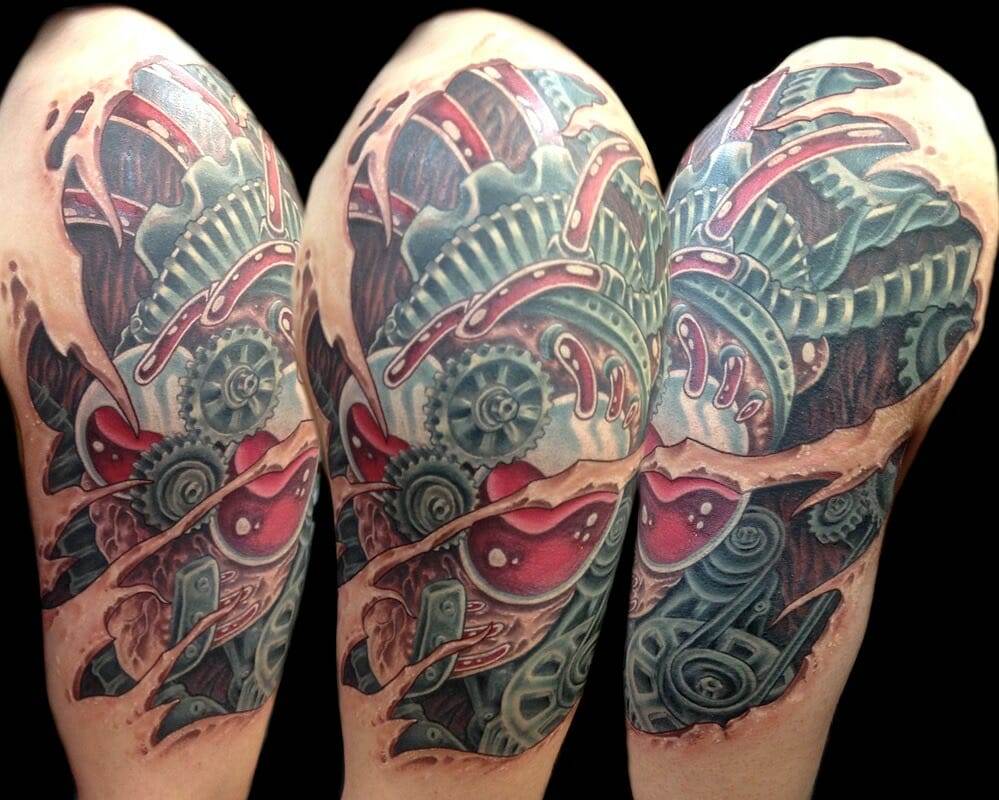Illustrative tattoos have become increasingly popular in recent years, with more and more people opting for this style of tattooing. Unlike traditional tattoos, which often feature bold lines and solid colors, illustrative tattoos are characterized by intricate details, shading, and a more realistic or artistic approach. These tattoos are like works of art on the skin, with each design telling a unique story or representing a personal meaning.
What sets illustrative tattoos apart from other tattoo styles is the level of detail and complexity involved. Artists who specialize in this style often have a background in fine art or illustration, which allows them to create stunning designs that resemble paintings or drawings. The use of shading, textures, and intricate linework gives these tattoos a three-dimensional effect, making them truly stand out.
The Inspiration Behind Illustrative Tattoos
Illustrative tattoos draw inspiration from a wide range of sources. Some popular themes include nature, animals, mythology, and fantasy. These tattoos often incorporate elements such as flowers, birds, wolves, dragons, or mythical creatures like unicorns or mermaids. Other common motifs include portraits of loved ones or famous figures, quotes or phrases that hold personal significance, or symbols that represent important values or beliefs.
The inspiration for illustrative tattoos can come from various sources such as books, movies, art history, or personal experiences. Many people choose to get tattoos that reflect their passions or interests, such as music, travel, or hobbies. Others may opt for designs that symbolize important milestones or life-changing events. The possibilities are endless when it comes to illustrative tattoos, as they can be customized to suit each individual’s unique story.
The Sketching Stage: Bringing Your Ideas to Life
Once you’ve found the right tattoo artist, the next step is to collaborate with them on bringing your ideas to life. The sketching stage is an essential part of the process, as it allows you to visualize how your tattoo will look on your body and make any necessary adjustments before the actual tattooing begins.
During this stage, it’s important to communicate your ideas clearly to your artist. Provide them with any reference images or inspiration that you have collected, and be open to their suggestions and feedback. A skilled tattoo artist will be able to take your ideas and translate them into a design that not only looks visually appealing but also works well with the contours of your body.
The Role of Color in Illustrative Tattoos
Color plays a significant role in illustrative tattoos, as it can enhance the overall design and bring it to life. The use of color can add depth, dimension, and vibrancy to a tattoo, making it more visually striking. Whether you opt for bold and vibrant colors or a more muted and subtle palette, the choice of color can greatly impact the final result.
When choosing colors for your illustrative tattoo, consider factors such as your skin tone, the placement of the tattoo, and the overall mood or theme you want to convey. Work closely with your tattoo artist to select a color scheme that complements the design and achieves the desired effect. Keep in mind that colors may fade over time, so it’s important to follow proper aftercare instructions to ensure your tattoo retains its vibrancy.
Placement Matters: Choosing the Right Spot for Your Tattoo

The placement of your illustrative tattoo is just as important as the design itself. The right placement can enhance the overall look of the tattoo and ensure that it flows well with your body’s natural contours. Consider factors such as visibility, symmetry, and how the tattoo will interact with other existing tattoos or body modifications.
When choosing a spot for your tattoo, think about whether you want it to be visible or easily concealable. Some people prefer to have their tattoos on areas that can be easily shown off, such as the forearm, upper arm, or calf. Others may opt for more discreet placements, such as the back, chest, or thigh. Take into account your lifestyle, profession, and personal preferences when deciding on the placement of your illustrative tattoo.
The Pain Factor: What to Expect During the Tattooing Process
It’s no secret that getting a tattoo can be a painful experience. The level of pain varies depending on factors such as the individual’s pain tolerance, the location of the tattoo, and the size and complexity of the design. However, it’s important to note that the pain is temporary and manageable.
During the tattooing process, you can expect to feel a sensation similar to a continuous scratching or stinging. Some areas of the body may be more sensitive than others, such as the ribs, feet, or inner arm. However, many people find that the anticipation of pain is often worse than the actual experience.
To manage pain and discomfort during the tattooing process, consider taking breaks if needed, practicing deep breathing or relaxation techniques, and communicating with your tattoo artist. They can adjust their technique or provide numbing creams to help minimize discomfort. Remember to stay hydrated, get a good night’s sleep before your appointment, and avoid alcohol or blood-thinning medications that can increase bleeding.
Caring for Your Tattoo: Tips for Proper Aftercare
Proper aftercare is crucial for ensuring that your illustrative tattoo heals properly and retains its vibrancy. Immediately after getting your tattoo, your artist will apply a protective ointment and cover it with a bandage or plastic wrap. Follow their instructions on how long to keep the bandage on and when to remove it.
Once the bandage is removed, gently wash the tattoo with mild soap and warm water. Pat it dry with a clean towel and apply a thin layer of fragrance-free moisturizer or tattoo aftercare cream. Avoid picking or scratching at the tattoo, as this can lead to scarring or infection. It’s also important to avoid exposing the tattoo to direct sunlight, swimming pools, saunas, or excessive sweating until it is fully healed.
Follow your artist’s aftercare instructions carefully and schedule a follow-up appointment if necessary. They will be able to assess the healing process and make any touch-ups if needed. Remember that the healing process can take several weeks, so be patient and take good care of your tattoo during this time.
The Emotional Connection to Illustrative Tattoos
Illustrative tattoos often hold a deep emotional connection for the wearer. They can represent important moments, people, or beliefs in someone’s life. For example, a tattoo of a loved one’s portrait may serve as a constant reminder of their presence or a tribute to their memory. Similarly, tattoos that depict symbols or quotes that hold personal significance can serve as daily reminders of one’s values or aspirations.
The process of getting an illustrative tattoo can also be an emotional experience in itself. For many people, it is a form of self-expression and a way to reclaim their bodies or mark a significant change or milestone in their lives. The act of choosing a design, collaborating with an artist, and enduring the pain of the tattooing process can be empowering and cathartic.
The Evolution of Illustrative Tattoos in Pop Culture
Illustrative tattoos have become increasingly popular in pop culture, with many celebrities and influencers sporting these intricate designs. They have been featured in movies, TV shows, and music videos, further cementing their place as a mainstream art form.
In recent years, illustrative tattoos have also gained recognition in the art world. Tattoo artists who specialize in this style have been showcased in galleries and museums, blurring the lines between fine art and tattooing. This recognition has helped elevate the status of illustrative tattoos as a legitimate form of artistic expression.

The Power of Illustrative Tattoos in Self-Expression
Illustrative tattoos are more than just ink on the skin; they are powerful forms of self-expression. They allow individuals to tell their stories, honor their loved ones, or showcase their passions and beliefs. The level of detail and artistry involved in illustrative tattoos sets them apart from other tattoo styles, making them truly unique and visually striking.
When choosing to get an illustrative tattoo, take the time to find the right artist who understands your vision and can bring it to life. Collaborate with them during the sketching stage to ensure that the design aligns with your expectations. Consider factors such as color, placement, and aftercare to ensure that your tattoo heals properly and retains its vibrancy.
Ultimately, illustrative tattoos are a beautiful and meaningful way to express yourself and create a lasting piece of art on your body. Embrace the power of this art form and let your tattoo tell your story for years to come.



